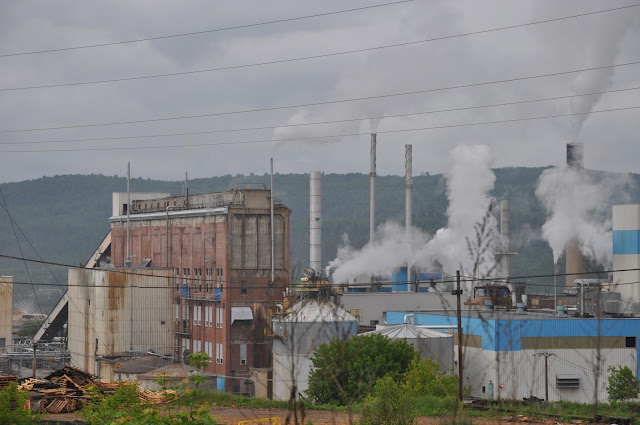- Raw logs to a mill from a log reload offline
- Chips from the lumber mill to the paper mill
- Various types of chemicals from multi-sources that are used in the paper manufacturing process
- Paper from the papermill to a paper converter
- Various chemical by-products which are shipped to numerous types of industries for their own use
- Paper sheets from the converter to a printer
- Coal and other products brought in for power generation
During the summer of 2001, I had the opportunity to take the family for a trip on the short-lived Timber Train excursion. Started by the Mattawa Temiscaming Excursion Co., the train was intended to shuttle tourists between Mattawa and Temiscaming, Que. for the day. The Timber Train used the existing Ottawa Valley RaiLink line, and RaiLink provided the power. During the stop in Temiscaming, you had the opportunity to walk and shop around the town, or go on a informative tour of the paper mill. Unfortunately, the 7.5 hour journey through the scenery of Ontario and Quebec ultimately did not survive. When the Timber Train went belly-up, the Adirondack Scenic RR picked up all or most of their cars at bargain-basement prices. Engines went back into RaiLink service. But for me, the tour of the paper mill was very much worth the entire trip. Informative from both how paper and pulp is made, but also informative from a railroad operations standpoint. No wonder the train staff was looking at me kinda funny as the train was entering the mill. I was the only one at the window trying to photograph every building and track in front of me. Ultimately armed with knowledge gained from trip as well as observing the other mills I discussed in Part 1, I would pattern the Spruce Creek Pulp & Paper mill after these operations as much as I could.
So let's start with a discussion with what the Spruce Creek plant produces and how it actually is made from the various raw materials which are needed. Similar to the Temiscaming mill, I modeled operations to include three main mills that manufacture different forest products, including specialty cellulose, high-yield-pulp and coated bleached board (containerboard) as well as a chemical products facility. The chemical products division produces a variety of products made from spent sulphite liquor (primarily alcohol, resin or lignin based).
 |
| Tembec's Temiscaming, PQ operation |
 |
| Temiscaming - Chemical Division in background; bark & chip storage buildings in foreground |
 |
| Temiscaming Specialty Cellulose Mill |
As I mentioned in Part 1, my Spruce Creek Pulp and Paper Mill is located on two 2’ by 6’ modules in the center of the room. Starting from the left side, my buildings include a power plant, the pulp mill, alcohol plant, acid building, kaolin building, specialty cellulose mill, board mill and the warehouse.
High Yield Pulp - the pulp mill is a manufacturing facility that converts wood chips or other plant fibre source into a thick fibre board which can be shipped to a paper mill for further processing. Pulp can be manufactured using mechanical, semi-chemical or fully chemical methods (kraft and sulfite processes). The finished product may be either bleached or non-bleached, depending on the customer requirements. In our mill, kraft pulp is produced using softwood pulp, while the "B" mill can produce either softwood or hardwood pulp. Similar to the Boardmill, final products are shipped via both rail and truck. The Kraft mill also produces large amounts of lignin liquor, a byproduct of the digestion process. This material can be shipped out in tankers, dried, or fed to other bacterias to make yeast. The Kraft mill also uses other chemicals such as sodium hydroxide (caustic soda) and sulfuric acid. Kaolin (slurry form) is brought in to make glossy paper. Kaolin is often supplemented by calcium carbonate (lime) slurry and titanium dioxide.
The Chemical plant consists of products which are made from the spent sulphite liquor generated within the facility. The plant can be divided into an alcohol division, resin division and lignin division. Most of this operation takes place within numerous tanks situated within three central buildings. Due to their relative size, I chose to model only the fronts of the buildings and blended the building into the photo backdrop.
Refined from wood pulp, specialty cellulose is used in a range of applications across many industries – cosmetics, pharmaceuticals, personal care, food, coatings, electronics and energy. Specialty cellulose is manufactured in both rolls and bales. Similar to the chemical plant, this area was modeled using only the front of the building set against the photo backdrop.
The Boardmill Division produces high quality paper and manufactures newsprint for publishers of daily newspapers and commercial printers, as well as controlled bulk paper for mass-market paperback book publishers and commercial printers. Coated bleach board is a product used for a broad range of commercial printing, publishing and packaging applications. Newsprint production uses wood fibre obtained from four separate sources, including thermomechanical pulp (TMP), recycled pulp, groundwood pulp and kraft pulp.
Part 3 will look at the rail operations inside the mill.
No comments:
Post a Comment